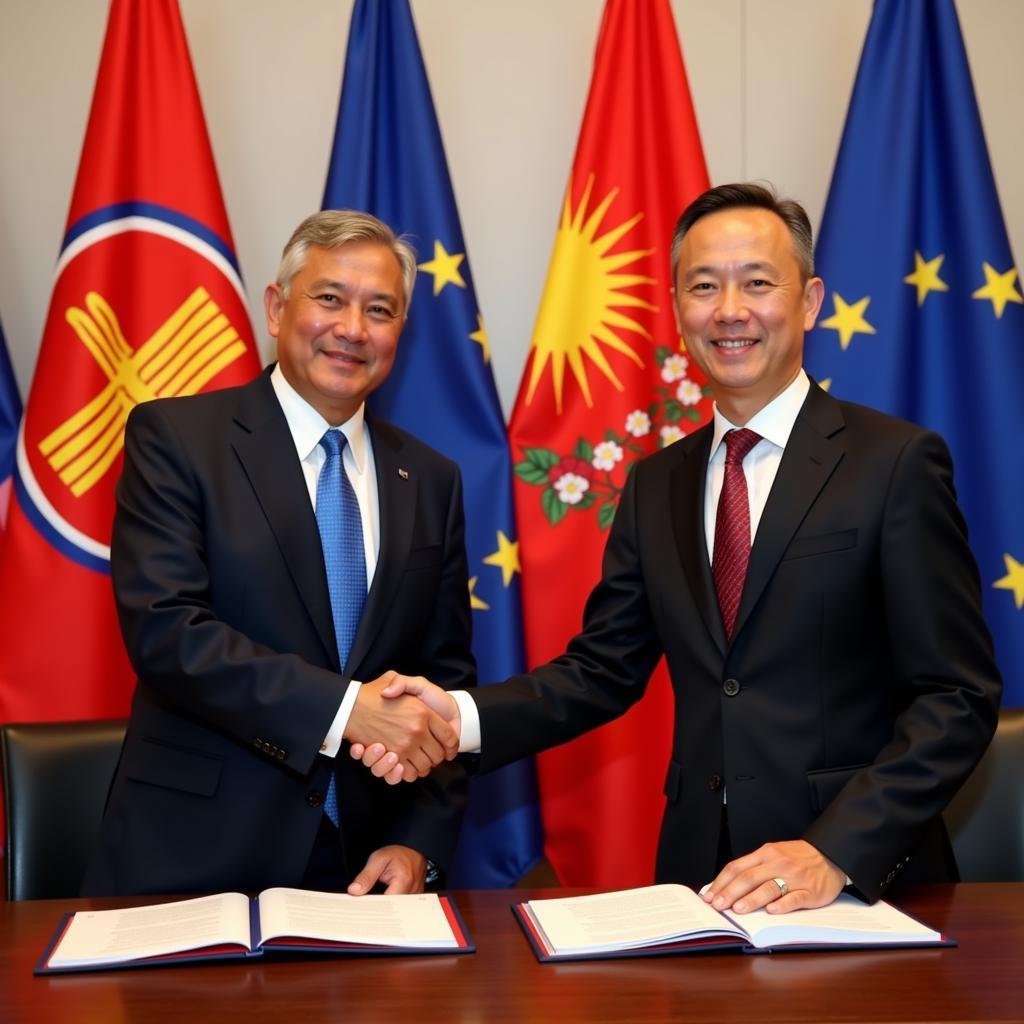Asean And Eu Economic Integration has become a focal point in the evolving landscape of global trade. This partnership, built on shared values and mutual interests, promises significant benefits for both regions. This article delves into the multifaceted aspects of ASEAN-EU economic cooperation, exploring its historical trajectory, current state, and future prospects.
Exploring the Synergies: How ASEAN and EU Integration Benefits Both
The ASEAN-EU relationship has evolved significantly over the decades. Initially focused on development aid, the partnership has broadened to encompass trade, investment, and technological cooperation. A key driver of this deepening engagement is the recognition of the complementary nature of the two economies. ASEAN, with its dynamic growth and youthful population, offers attractive investment opportunities for EU businesses. The EU, in turn, provides ASEAN with access to advanced technologies, expertise, and a vast consumer market. This mutually beneficial relationship fosters economic growth and development in both regions.
Key Areas of Cooperation: Trade, Investment, and Beyond
ASEAN and EU economic integration extends beyond traditional trade and investment flows. Cooperation in areas such as sustainable development, digital economy, and connectivity are becoming increasingly important. The EU’s commitment to supporting ASEAN’s regional integration agenda, including the ASEAN Economic Community (AEC), further strengthens the partnership. Joint initiatives in areas like climate change mitigation and disaster management demonstrate the shared commitment to addressing global challenges. These diverse areas of collaboration create new avenues for growth and contribute to a more resilient and interconnected global economy.
Overcoming Challenges: Navigating the Complexities of ASEAN-EU Integration
While the potential benefits are significant, ASEAN and EU economic integration also faces certain challenges. Differences in regulatory frameworks, standards, and business practices can create obstacles to seamless trade and investment. Addressing these issues requires ongoing dialogue and cooperation to harmonize regulations and streamline procedures. Furthermore, geopolitical factors and global economic uncertainties can impact the pace of integration. However, the strong political will and commitment from both sides underscore the determination to overcome these challenges and further strengthen the partnership.
 Future of ASEAN-EU Collaboration
Future of ASEAN-EU Collaboration
The Future of ASEAN-EU Economic Cooperation
The future of ASEAN and EU economic integration looks promising. The pursuit of a comprehensive free trade agreement remains a key priority, further enhancing trade and investment flows. Continued collaboration in emerging areas like the digital economy and green technologies will unlock new opportunities for growth and innovation. By fostering greater understanding and trust, ASEAN and EU are building a robust and enduring partnership that contributes to a more prosperous and interconnected world. ase vs aks
What are the key drivers of ASEAN-EU economic integration?
The key drivers are mutual economic benefits, complementary economies, and the desire for increased trade and investment.
How does ASEAN benefit from EU integration?
ASEAN benefits from access to advanced technologies, expertise, a large consumer market, and support for its regional integration agenda. ap-asean
What are the main challenges to ASEAN-EU integration?
The main challenges include differences in regulatory frameworks, standards, business practices, and geopolitical factors. asean business conference
What is the future outlook for ASEAN-EU economic cooperation?
The outlook is positive, with a focus on a comprehensive free trade agreement and collaboration in emerging areas like the digital economy and green technologies. ase usi global
Conclusion: A Partnership for Shared Prosperity
ASEAN and EU economic integration offers a compelling example of how regional cooperation can drive global growth and development. By leveraging their respective strengths and addressing common challenges, ASEAN and EU are forging a partnership that benefits both regions and contributes to a more prosperous and interconnected world. This ongoing collaboration promises to shape the future of global trade and investment for years to come. asea member discounts
 ASEAN-EU Handshake Agreement
ASEAN-EU Handshake Agreement
Dr. Maria Fernandez, Senior Economist at the Institute for European Studies: “The ASEAN-EU partnership represents a strategic alliance with immense potential. By fostering greater economic integration, both regions can unlock new opportunities for growth and innovation.”
Mr. Lee Kuan Yew, prominent ASEAN business leader: “ASEAN’s dynamic economies and youthful population provide attractive investment opportunities for EU businesses. This partnership is crucial for ASEAN’s continued economic development.”
FAQ
- What is the ASEAN Economic Community (AEC)?
- What are the main trade agreements between ASEAN and the EU?
- How does ASEAN-EU cooperation contribute to sustainable development?
- What are the key sectors for investment in ASEAN by EU companies?
- How can businesses benefit from ASEAN-EU economic integration?
- What are the cultural differences to consider when doing business between ASEAN and EU?
- What are the future prospects for ASEAN-EU economic relations?
When needing assistance, please contact Phone Number: 0369020373, Email: aseanmediadirectory@gmail.com Or visit us at: Ngoc Lien Village, Hiep Hoa, Bac Giang, Vietnam. We have a 24/7 customer service team.